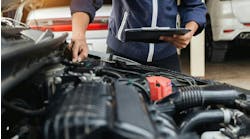"Developing competency and profitable productivity in handling flex fuel vehicles requires that today's professional technicians change how they think," Seyfer says. "They need to not only understand the basic chemistry involved, but also be cognizant of the strategies that automakers and their engineers build into vehicles, and then develop sound diagnostic strategies for the various types of flex fuel systems, such as using and interpreting five-gas analyzer numbers."
What's in the tank affects driveabilitySHOP KEYS1. E85 and gasoline behave differently in internal combustion engines.2. Take available online certification for servicing flex fuel vehicles.
3. Know the fuel. Alcohol content matters. Ask, then verify by testing the fuel in the tank.
4. Use the right tool. Let five-gas analysis be your friend.
5. Improve your competency with flex fuel tools.
Simply put, although flex fuel vehicles look the same as their gasoline-powered counterparts, there are substantial differences in the engine chemistry. Compared to gasoline-powered cars, the presence of alcohol in ethanol blends creates chemical reactions that are different that what a technician would normally expect.
Moreover, ethanol blends lead to cars behaving differently at different altitudes and in different climates. In colder climates, a flex fuel vehicle just filled up with E85 in the winter may not start the next morning. During a change from E85 to gasoline or vice versa, the vehicle could start up but run very roughly for a time, leading an owner to take his car to his shop.
In addition, oxides of nitrogen (NOx) levels can be lower with E85 than with gasoline, because E85 has lower combustion temperatures. An unaware technician who tries to diagnose and resolve the perceived problem could inadvertently travel down the wrong path, thereby wasting time, decreasing productivity and profitability - as well as possibly damaging a customer relationship.
A game of musical chairs(Photo-Snap-on)
Because flex fuel vehicles can run on gasoline or ethanol blends up to 85 percent ethanol content, automakers have complex strategies for flex fuel vehicles. Knowing what strategies and processes the OEMs are employing can help a technician know what to expect, then make the right diagnosis and subsequent repair, if one is even needed.
Ford began its alcohol program using a sensor that detected the amount of alcohol in the system. Upon finding that these were not terribly reliable, Ford engineers abandoned the sensor in favor of a complex oxygen sensor and fuel level sensor-based strategy. GM also utilized an alcohol sensor, despite Ford's failures, and is now utilizing a Virtual Flex Fuel Sensor - which means that they have gone to a similar strategy as Ford.
Fortunately, the OEMs are ready and willing to help technicians - independent or dealership. For example, both Ford and GM (Check this at show) have flex fuel training and certification available online. In addition, tools exist that can put the knowledge into practice. But it's also critical that automotive professionals undertake to learn the full functionality available to them with these tools. Otherwise, even with information and tools present, a technician's tool competency becomes the barrier to responsible service.
Change your thinking"Developing competency and profitable productivity in handling flex fuel vehicles requires that today's professional technicians change how they think.""When a customer enters a shop with
a flex fuel vehicle, they should always be asked what fuel is normally used and what was put in at the last fill-up," notes Seyfer. "More importantly, before anything fuel-related is done,
the service technician should collect a sample and perform an alcohol content check using a graduated cylinder."
This simple first step can shorten the diagnostic process and lead to the effective solution without aggravation - to the technician, shop owner and customer.
For technicians who have to service flex fuel vehicles, there are idiosyncrasies when engines run on straight gasoline and then switch to E85 or some other ethanol blend, and vice versa.
"Adopting the use of five-gas analyzers and learning how scan tool data and parameter identifiers will change can really help technicians deal with the different challenges hat flex fuel presents," says Seyfer.
INFORMATIONTOOL KIT
Ford flex fuel online training and certification
National Ethanol Vehicle Coalition
E85 related Links
"Contrary to what technicians are used to with gasoline-powered vehicles, carbon dioxide and oxygen readings are dramatically different with E85," he explains. "Compared to gasoline, with E85, CO2 readings will be lower and O2 readings will be higher than what one would normally expect." Consequently, it's imperative that technicians who service flex fuel vehicles learn those differences and adjust their diagnostic procedures.
With flex fuel and other emerging alternative fuels, technicians and shop owners need to adapt. Not only is a willingness to change thinking necessary, the associated OEM technologies and strategies requires that new diagnostic practices and tools be developed and used properly to resolve customer problems quickly and efficiently.
It's a brave new world - don't let it pass you by.


